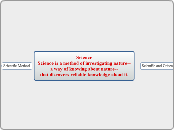ScienceScience is a method of investigating nature--a way of knowing about nature--that discovers reliable knowledge about it.
Scientific and Critical Thinking
Critical thinking is thinking correctly for oneself that successfully leads to the most reliable answers to questions and solutions to problems
scientific and critical thinking are the same thing, but where one (scientific thinking) is always practiced by scientists, the other (critical thinking) is sometimes used by humans and sometimes not
The Three Central Components of Scientific and Critical Thinking
1. Empiricism: The Use of Empirical Evidence
2. Rationalism: The Practice of Logical Reasoning
3. Skepticism: Possessing a Skeptical Attitude
Scientific Method
The scientific method has proven to be the most reliable and successful method of thinking in human history, and it is quite possible to use scientific thinking in other human endeavors
The Steps
1. One must ask a meaningful question or identify a significant problem, and one should be able to state the problem or question in a way that it is conceivably possible to answer it.
2. One must next gather relevant information to attempt to answer the question or solve the problem by making observations
3. Now one can propose a solution or answer to the problem or question. In science, this suggested solution or answer is called a scientific hypothesis, and this is one of the most important steps a scientist can perform, because the proposed hypothesis must be stated in such a way that it is testable.
4. Next, one must test the hypothesis before it is corroborated and given any real validity
5. If the hypothesis fails the test, it must be rejected and either abandoned or modified
6. The final step of the scientific method is to construct, support, or cast doubt on a scientific theory
